A Look at the Humor of “Haré + Guu”
Some months ago, I wrote in my Avatar retrospective that the humor in anime comedies just could not compare to that of our domestic cartoons. The Japanese and Americans have two different senses of humor, which are buried deep into our cultural upbringing. Domestic cartoons featured more sarcasm and cynicism into their humor, which are both concepts not that prevalent in Japanese culture. On the other hand, anime comedies feature a lot jokes from the tsukkomi-boké formula, where a straight man (tsukkomi) punishes the stupidity of an idiot (boké). While tsukkomi-boké can translate to a vaudevillian slapstick to an American viewer, it mostly fails to produce the same kind of laughter as it does in Japan.
Well, not long after I wrote that, I came across one anime show that completely blew this generalization right out the window. At the start of August, I signed up for Fios TV service in my apartment, and much to my surprise, it came with the FUNimation Channel. Now, the FUNimation Channel is still very new, and from what I hear, it’s only available over Fios. That is why it is no surprise that the channel only appears to air about a dozen shows on repeat. But even with the limited selection of shows, they had one that I’ve been meaning to watch for a while now, Haré + Guu.
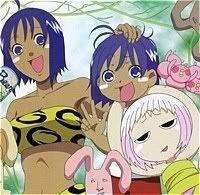 Haré + Guu is the story of boy named Haré who lives in a small jungle village with his mother, Weda. After a night of partying, Weda unexplainably brings home an adorable pink-haired girl named Guu to live with them. But after a while, Haré discovers that Guu is not at all what she appears to be, and she makes his world a nightmare with all her crazy antics. The original Japanese title, Jungle wa Itsumo Hare Nochi Guu, is a play on Haré’s name meaning “sunny and nice” and can be interpreted as “the jungle was always nice, and then along came Guu.”
Haré + Guu is the story of boy named Haré who lives in a small jungle village with his mother, Weda. After a night of partying, Weda unexplainably brings home an adorable pink-haired girl named Guu to live with them. But after a while, Haré discovers that Guu is not at all what she appears to be, and she makes his world a nightmare with all her crazy antics. The original Japanese title, Jungle wa Itsumo Hare Nochi Guu, is a play on Haré’s name meaning “sunny and nice” and can be interpreted as “the jungle was always nice, and then along came Guu.”
And my God, this show is funny!
It is really f@#$ing funny!
It is the funniest anime I have ever seen and clearly does not just play into the traditional tsukkomi-boké formula. There is something very unique about this show that you don’t get with other Japanese comedies. So this week, I’d like to take an analytical look at the humor of this show and why it translates so well even to this American otaku.
The Callback
While watching the show, one particular gag I noticed in Haré + Guu is the art of the “callback” humor. This is the act of performing a joke, and then repeating the same joke again at a later time in an unexpected moment. We see it appear from time-to-time in American cartoons and sitcoms, but I don’t recall it being used all that often in Japanese comedies.
We first encounter this joke seven minutes into the first episode. Haré had just given his mother some attitude because he felt that she did not properly comfort him when he was worried about something. She returns the attitude by telling her son that if he complains to her once again, he’s “going down.” She says this threat in a very intimidating way, looking like some “tough guy” from an action anime.
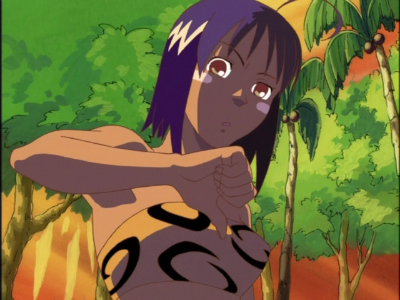
Okay, so that gag is only slightly funny. But then 5 minutes later into the episode, after several scenes have passed and the plot changes to introduce Guu as a new character, Haré is once again crying to his mother over something wrong with Guu. Weda reminds Haré about her threat from earlier, and makes the exact same “tough guy” facial expression to emphasize that she means it this time. This is the callback to the joke from earlier, and surprisingly, it’s a lot funnier the second time.
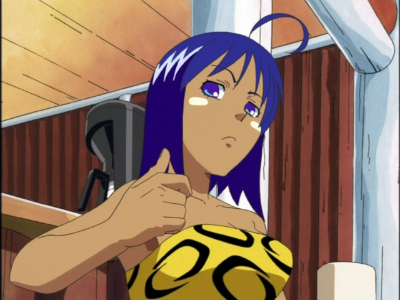
But callbacks don’t always have to happen in pairs in even that closely to each other. The end of the first episode, Haré is taken into a world within Guu’s stomach and interacts with two young people living in there. This “world inside Guu’s stomach” becomes a recurring joke throughout the entire series, and is always called back at very unexpected moments. At the end of the second episode, all of Haré’s classmates recall a strange dream they were all having that seemed to have taken place inside of Guu’s stomach. And then in episode 8, a new girl randomly gets swallowed up by Guu, and ends up living inside Guu’s stomach with the two young people from before.
I think the reason why the callback joke works so well is that the viewer is reminded about watching the joke in past. It doesn’t matter if the callback is to a joke that happened minutes ago or years ago, the viewer’s memory recall goes into full throttle when they see it again. It is this personal déjà vu that that viewer experiences that heightens the impact of the joke the second time, thus making it a much funnier gag.
Domestic cartoon fans might be familiar with this gag in the show Family Guy. In a scene that aired in one of the show’s early seasons, the main character, Peter, falls onto a sidewalk, scrapes his shin, and spends an uncomfortable amount of time wincing in pain on the ground. In a new episode that aired many years later, this gag is repeated almost verbatim, resulting in Peter wincing again in the exact same way he did before.
Timing is key with the callback joke. It’s different then just having a repetition joke, which Haré and Guu also features. This would be telling a joke, then immediately repeating the joke with a slight variation, and then most likely repeating a third time right afterwards. This is an example of the “rule of three” philosophy in the writing world.
But with a callback joke, you have to make the audience forget about the joke, move on to other things, and then suddenly surprise them again with it. While the “you’re going down” callback did happen only five minutes later in the episode, you had a major plot development (the introduction of Guu) in that five minute span to completely distract the audience. Once the audience becomes more interested in Guu than Weda… bang! You hit them with the Weda joke again.
Sexy Mama
And speaking of Weda, there’s another key joke that doesn’t come up that often, but when it does, it gets a pretty big laugh out of me. I think I can pin down the source of these jokes to one key fact:
Haré has got one hot mama.
With a full figure, scantily clad jungle clothing, and wild personality, Weda becomes the show’s key sex symbol. She is the object of lust with several of the show’s characters. However, the only kind of sexuality she shows is only to tease her own son, diving into some sort of bizarre reverse Oedipus complex.
After Haré gets scared of a giant monster, he runs towards his mother and latches onto her a full force. Weda, who was busy pealing vegetables with her friend, ends up being knocked to the ground by her son. As the boy trembles on top of his mother, the girls tease him as if he’s trying to be sexual about it
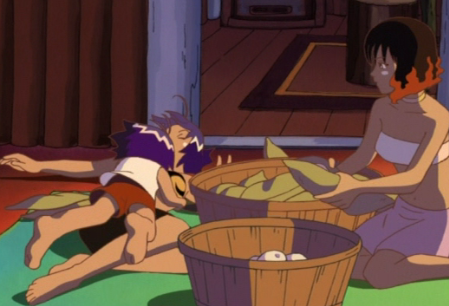
“Wow,” Weda’s friend remarks, “he’s so bold to be doing that in broad daylight.”
“He’s just like his father!” giggles Weda.
The humor of the “hot mama” gag can probably be best explained domestically with the 1999 teen comedy American Pie. One of the movie’s most memorable jokes was how the young boys of the movie would lust after the mother of one of their buddies. The joke was so popular that the acronym the movie created to describe it, MILF, is now a widely accepted (albeit vulgar) slang term used to describe attractive older women.
The MILF jokes gets its strength from the idea that it’s inappropriate to think of anyone’s mother in a sexual way. It is a taboo, and it is meant to make the child of the hot mama feel embarrassed that she is perceived in such a way.
The way that it makes such a huge impact in Haré + Guu is that the show typically stays away from sexual humor. It’s not supposed to be a sex comedy. And yet every single dirty joke is always about Weda. The mysterious Dr. Clive character is constantly trying to get in bed with her. One of Haré’s teenage classmate has a crush on her. And Weda’s former maid, a female, gets a nosebleed whenever she thinks of her mistress, a common Japanese sign of sexual arousal.
But again, no matter how much attention she gets from other suitors, the only sexual attention she’ll ever give is to tease her son, who does not enjoy any of it. It’s odd, and pretty disgusting when you look at it, but this shock humor adds to the uniqueness of this series.
Suspension of Disbelief
But in all my analysis of the humor of this series, I believe that the core to most of the jokes, and probably the ultimate theme of the entire anime, is something completely unique and unlike anything I have seen in either Japanese or American comedy. We first see it within the first episode when Haré is going through the jungle gathering bananas. Along the way, he stops and stares at the unusually hideous creature:
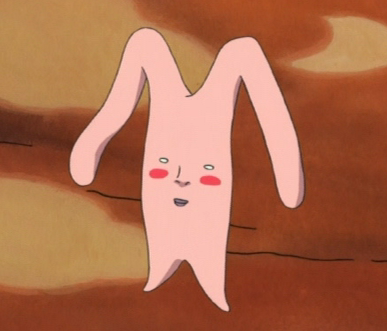
“Oh, it’s just a little pokute,” he nonchalantly remarks, and moves along with his business. The joke is on us at this point, because how the hell are we supposed to know that this ugly looking creature is actually considered normal to Haré?
More to the point, what is supposed to be considered “normal” in the world of Haré + Guu?
The fact that we are watching a show about a blue-haired boy and a pink-haired girl alone makes this story completely unrealistic to the viewer. Just to accept the base premise of the show, or any anime show, we have to suspend our disbelief and just accept that these odd looking humans can walk and talk like a real life human can.
But when we do this, we also set boundaries in our own heads as to what’s acceptable in this fantasy world and what’s not acceptable. Sure, Haré is a blue-haired boy with huge eyes, but since we don’t see him flying anywhere, we assume that he cannot fly, just like he wouldn’t be able to in real life. Sure they are living in a fictional jungle, but because the characters are wearing summer clothing and eating bananas, we assume that the weather is tropical just like in a real life jungle.
And that’s exactly where Haré + Guu will get you. It forces you to suspend your disbelief and establish such boundaries in your head, and then crushes them completely when something unexpected happens. Haré actually symbolizes the viewer in this regard because he will be shocked when something odd happens. But he is the only one in the series that does so because if something happens that goes against the viewer’s suspension of disbelief, everyone else in the show acts as if it’s been “normal” the whole time.
When we first meet Guu, she is sweet, charming, and absolutely adorable. And she is like this long enough for the viewer to accept her as that type of character. But then without any warning, Guu turns into a gloomy and depressing girl, which comes much to the shock of both Haré and the viewer. However, when he goes to consult his mother on this unexpected change, Weda sees no problem. The gloomy Guu appears to be “normal” to her.
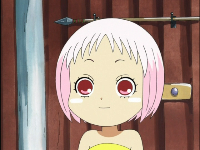
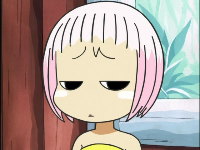
So Haré and the viewer have to establish that this a normal character trait for Guu. She’s always charming when she meets someone for the first time, but then turns depressing after the first impression runs out. So in the next episode when he takes Guu to school for the first time, we’re all expecting to see the “sweet and charming” Guu introduce herself to her classmates. But then, much to the surprise of everyone once again, Guu remains gloomy and depressing during the introduction, thus crushing that assumption we all made about her character.
The way that Haré reacts to these unexpected moments is very tsukkomi-like. He’s criticizing acts of stupidity, and often yells and screams about how something’s not right with the situation. However, if he’s the straight man tsukkomi, who exactly is the idiotic boké?
I think the boké is our suspension of disbelief. We, as the viewers, actually try to establish some form of normality in this fictional world of anime. However, the anime calls us out on it by proving that there is nothing “normal” about cartoons after all.
And that is why this show is so f@#$ing funny.
So if you play by the traditional rules of Japanese comedy, the humor is just not going to translate as well when you bring it overseas as it was in its native language. However, Haré + Guu does not play by traditional rules of Japanese comedy. It perfects the art of the callback joke and MILF humor, which have proven to work well in our own domestic comedies. But the core of its humor, toying with the viewer’s suspension of disbelief, is very unique to the medium of anime and manga. It translates perfectly well to both Japanese and American otaku, and in my opinion, makes this the funniest anime out there right now.